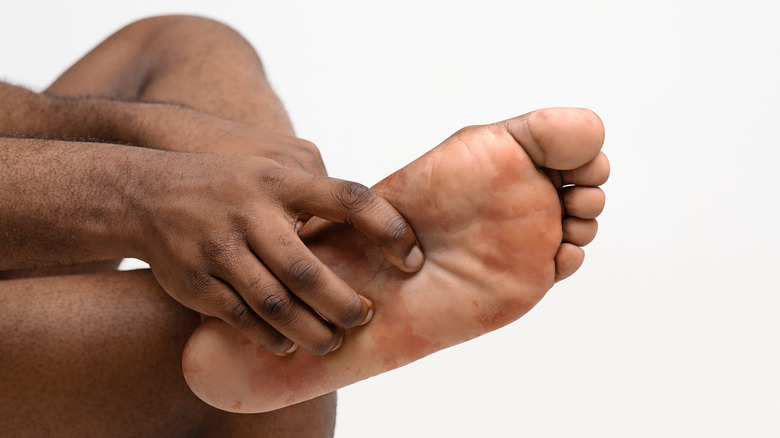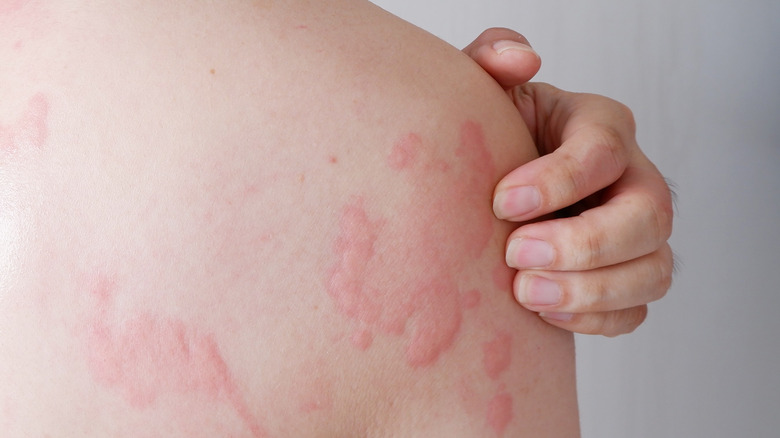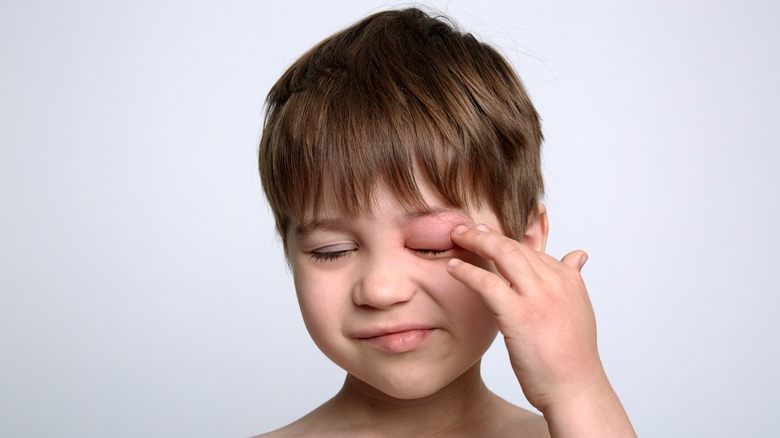Symptoms Of Angioedema Explained
Angioedema is swelling that occurs in the body's tissues, typically triggered by an allergy. It can also often be accompanied by hives, due to tiny blood vessels overfilling throughout the body (via the Cleveland Clinic). Angioedema can cause a range of symptoms as swelling affects the eyes, lips, face, skin, or throat, according to the Asthma and Allergy Foundation of America. Swelling of the throat can even cause an allergic emergency, requiring emergency treatment with a drug called epinephrine. Since angioedema can impact any of the mucous membranes, it can cause swelling of the airways, which means it can be dangerous and cause death if symptoms are severe. Although angioedema is often due to an allergic reaction, it is not always, and can be a non-allergic or hereditary pathology. There are actually several different types of angioedema. Let's explore the various categories of angioedema, their possible causes, and the symptoms that might be experienced.
Types of angioedema
There are various subtypes of angioedema, and not all are due to allergic food or medication reactions (via the Cleveland Clinic). Angioedema may be an acute allergic reaction, a non-allergic drug reaction, or may be idiopathic, hereditary, acquired, or vibratory in nature. Symptoms and treatment may vary according to the type of angioedema.
Hereditary angioedema occurs due to a genetic chromosomal mutation, most often due to family history, but also on occasion because of a spontaneous gene mutation, according to the US Hereditary Angioedema Association. People with hereditary angioedema typically present with symptoms before age 13, and symptoms may become worse after adolescence. Trauma, stress, pregnancy, or use of birth control may provoke symptoms. Antihistamines or corticosteroids do not effectively treat this type of angioedema. Acquired angioedema is very rare and is associated with lymphoproliferative disorder. Idiopathic angioedema presents with hives or swelling for a longer duration than other types, beyond several weeks or more. It can sometimes be a sign of thyroid dysfunction or and is often not responsive to antihistamine blockers.
The allergic type of angioedema is the most common presentation of angioedema. Allergic angioedema occurs as a reaction to an environmental trigger such as a food allergen, temperature, medications, bee stings, or latex. Another rare form of angioedema is ACE-Inhibitor angioedema, which is caused by ACE-inhibitor treatment for high blood pressure. It can be triggered at first use of medications like captopril, enalapril, or genzapril, or even years after the first use.
Causes of angioedema
According to an article published in the Journal of the American Medical Association, angioedema can have a range of causes. Causes can vary depending upon the type of angioedema. Allergic angioedema, for example, is caused by external allergens such as insect stings, medications like antibiotics, or foods like shellfish and peanuts. During an allergic reaction, the body releases chemicals such as histamines into the bloodstream, signaling a foreign element to the immune system, which can react at times in an aggressive way.
Nonallergic drug-induced angioedema is induced by prescription drugs such as those prescribed for blood pressure. Acquired angioedema is correlated with infection, autoimmune disease, and, less often, cancer malignancy such as that found in lymphoma. Finally, idiopathic angioedema has no determined cause.
According to Mount Sinai, infections or autoimmune diseases such as lupus can also trigger angioedema. Hereditary angioedema can run in families. Yet, it is also important to note that the cause of symptoms in many cases of angioedema is never found.
How angioedema is diagnosed
If you are seen for symptoms, a doctor or health care provider will typically check your skin for swelling and discoloration and may also check your breathing sounds. They will often ask you if you've consumed any allergens or new medications or have been exposed to any toxic irritants (via Mount Sinai). Your provider will look for markers that indicate the cause of your symptoms. Once urgent symptoms are treated, allergy tests may be conducted.
If your provider suspects your angioedema may be hereditary in nature, they may order further blood work to gather more information (via Discover HAE). Signs of hereditary angioedema may include symptoms that do not respond to antihistamines, epinephrine, or glucocorticoids. A family history may also be taken. Patient health history may include repeated angioedema in the extremities, face, airways, or gastrointestinal tract, without hives (urticaria) or itching.
Research on hereditary angioedema also indicates that the reason that body tissue produces swelling is dysregulated bradykinin levels. Bradykinin is a peptide that regulates inflammation in the body, and an overproduction can elevate the permeability of veins and arteries, leading to angioedema symptoms. This differs from allergic angioedema, which is a response to elevated histamine levels.
Swelling below skin
There are a wide variety of symptoms that might be seen in angioedema patients. The hallmark symptom of angioedema, however, is a pronounced swelling of the skin, occurring in the skin tissue below the mucus membrane, according to the Cleveland Clinic. This skin tissue layer is called the dermis. The fluid from small blood vessels overfills the tissues, causing inflammation and swelling. This happens quickly and typically lasts one to two days.
It's important to seek medical care if you experience uncomfortable, painful, or unusual swelling, according to the Asthma and Allergy Foundation of America. It's critically important to call 911 or seek immediate emergency room care if the swelling you experience is severe, covers a large portion of your body, or is accompanied by additional symptoms, especially trouble breathing. If you are experiencing angioedema of the throat, it is life threatening. Medical providers will treat this condition by administering emergency medicine epinephrine.
Welts or hives (urticaria)
In addition to swelling, angioedema is often accompanied by welts or hives — also called urticaria, according to the Mayo Clinic. Welts can vary in size. Hives are sometimes, but not always, the result of food or medication triggers. Luckily, the majority of the time hives are short-lived and don't leave lasting marks or long-term effects. If hives last longer than several weeks, however, they are considered to be chronic. Though hives typically will vanish on their own without intervention, sometimes medication can be prescribed to help relieve symptoms such as itchiness and swelling.
Some common triggers for urticaria include foods such as shellfish, eggs, and nuts, or ingredients that might be added to food, such as additives, dyes, and chemical preservatives (via Drugs.com). Bug bites or bee stings, plants, pet dander, latex, and medications such as antibiotics or even ibuprofen can also act as triggers. Sometimes even colds, mononucleosis, or stress can prompt hives, as well. Emergency medical care providers will know how to assess your condition and may use antihistamines or steroids treat redness, discomfort, and swelling, or epinephrine for more serious reactions where anaphylaxis is a risk.
Swelling on the face
Facial swelling can present in angioedema cases. Angioedema can cause chemosis, or swollen eyes, according to Mount Sinai. Another word for this swelling of tissue lining eyelids and the surface of the eye is conjunctiva. The buildup of fluids resulting from angioedema that causes chemosis is often due to an allergic reaction. It's very important to seek immediate medical attention for swelling around the eyes if you can't close your eyes, your symptoms persist, or your chemosis is also accompanied by eye pain, vision changes, respiratory difficulties, or fainting.
Angioedema can also cause swelling of the lips (via American Celiac). Though this swelling will typically subside on its own, seek emergency care if facial swelling affects your tongue and throat (per NHS Inform). If you do seek medical care, your health care provider will provide a physical exam and ask you about the onset and nature of your symptoms. They may offer medication to reduce the swelling. Your medical provider will also assess you for other symptoms of angioedema and try to determine the underlying cause.
Abdominal cramping
Less commonly, angioedema may cause abdominal cramping. This symptom of angioedema is associated with the rare hereditary type angioedema, according to an article published in Clinics and Research in Hepatology and Gastroenterology. Painful attacks of abdominal pain can occur, often resulting in an initial misdiagnosis of appendicitis or other unrelated pathology. Hereditary angioedema may also produce other non-urticaria symptoms such as edema of the face, extremities, genitalia, or respiratory tract.
There is no cure for hereditary angioedema, but there are treatments that can arrest symptoms (via The New York Times). This condition is inherited and usually involves an inability to produce sufficient amounts of C1-inhibitor, which is a protein that regulates tissue inflammation. This disorder sometimes presents as intestinal swelling and pain in women, triggered by estrogen from pregnancy or birth control medication. Researchers are still trying to understand exactly how HEA works, but genetic testing can confirm diagnosis and allow monitoring and treatment of potentially uncomfortable or dangerous symptoms.
Breathing difficulty and when to seek help.
In the most dramatic cases of angioedema, swelling of the throat and breathing passages can occur (via Medical News Today). This is the most dangerous symptom of angioedema. Anaphylaxis is a life-threatening emergency, which is why people with severe allergies may need to carry an autoinjector or EpiPen, according to Harvard Health Publishing. Anaphylactic shock or allergic shock can develop within only moments of exposure to an allergen. Food, medications, environmental allergens, or bee stings are some examples of anaphylactic triggers.
If swelling of the mucous membranes in the throat is extreme enough, it can block the passage of air. While angioedema that does not impact breathing usually subsides within days without harm, breathing difficulty can be lethal, according to Penn Medicine. It is critical to seek emergency medical care if angioedema is severe or if you are experiencing new or worsening symptoms. Be sure to call 911 or head to your local emergency room if you are wheezing, struggling to breathe, or fainting. If you know you were exposed to a known food or allergy medication, or you note that your lips, mouth, or tongue are swelling, you should also seek immediate care (via Mayo Clinic).
Treatment and prevention
If you know you are at risk for angioedemic anaphylaxis, there are preventative cautions that your medical provider may help you put into a care plan (via Drugs.com). Knowing — and trying to avoid — your allergens or triggers, carrying a medical alert ID card or jewelry, carrying two shots of unexpired epinephrine and knowing how to use them, and keeping a food or allergen diary may be part of the prevention plan you make with your allergist or other healthcare provider.
According to an article published in the Journal of the American Medical Association, angioedema sometimes resolves on its own. Other times, it requires drug treatments such as antihistamines, steroids, or epinephrine injection. Sometimes icing and cold compresses can help ease the discomfort of swelling. Depending on the type of angioedema, your doctor will prescribe appropriate treatment. Your provider will also educate you and your family on how to respond appropriately if angioedema occurs again, and how to prevent it. Avoiding known triggers is key. For concerns such as progressive angioedema symptoms or trouble breathing, always seek emergency room care.










